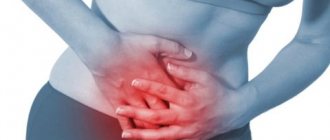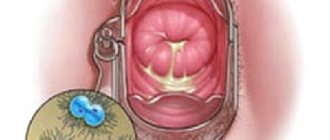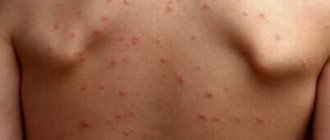Menarche, or the first period in girls, is an indicator of reproductive health and should occur at the time set by nature. The normal age for the onset of the first menstruation is adolescence. Harbingers of menstruation include aching, nagging pain in the lower abdomen and lower back, increased appetite, drowsiness, and irritability.
At what age do the first periods begin?
{banner_banstat0}
Menarche, or first menstrual bleeding, is the central event of puberty. This is a sign that a girl’s reproductive system is ready to reproduce.
Normally, menarche begins between the ages of 12 and 14 years. The formation of the menstrual cycle is influenced by heredity, climatic factors, the girl’s weight, quality of nutrition, the presence or absence of diseases of the endocrine glands, and other health problems.
In rare cases, menstruation begins at age 9. In this case, they talk about early puberty, but this is not a sign of pathology. If menstruation is absent at the age of 15 years and older, then the girl is diagnosed with “primary amenorrhea.” In this case, the teenager needs to be thoroughly examined.
https://youtu.be/Wzdb8Wzqims
Irregular menstrual cycle
The interval between menstrual bleeding lasts 1.5-2 months or more (delay).
- Polycystic ovary syndrome (PCOS) is the most common cause. Menarche occurs on time, but after a few months menstruation becomes rare (oligomenorrhea) or stops (amenorrhea). Possible uterine bleeding. Hair growth on the skin of the face and/or body may increase and follow a male pattern. Sometimes obesity develops.
- Increased production of male sex hormones in congenital dysfunction of the adrenal cortex. Early onset - girls from birth have external signs of boys, later - manifestations are similar to PCOS.
The first signs of menstruation in girls
You can assume that the first critical days will soon begin a year before menstrual bleeding.
What to pay attention to:
- The figure changes according to the female type. A mother has to buy her child's first bra.
- The reproductive organs enlarge, hair appears on the pubis and in the armpits.
- The sebaceous glands begin to work actively. Acne appears on the face and body, hair becomes oily, and seborrhea may develop.
- Leucorrhoea is a white vaginal discharge that does not cause discomfort. As they mature, they become more viscous and abundant.
- Aching pain without signs of inflammation in the lower abdomen. These symptoms can be observed several months before menarche, or just before the first menstruation.
- Changes in behavior in adolescents, tearfulness, frequent mood swings, aggression. This is the same PMS as an adult woman.
Physiological symptoms of the first menstruation
- Painful sensations in the lower abdomen, the degree of their intensity varies from barely noticeable to clearly expressed pain.
- Sudden mood swings for no apparent reason, a tendency to react with tears and resentment.
In the future, these and other symptoms known to most women will form a single set of signs of menstrual symptoms.
Depending on the individual character of the girl and the characteristics inherited from her mother, the first menstruation can be either heavy and prolonged, or painless and practically asymptomatic.
As a rule, the main symptoms of the onset of menstruation can be traced to one degree or another in most girls and women. These are painful sensations during menstruation, changes in psychological state, changes in appetite, general weakness and fatigue.
What are girls' first periods like?
{banner_banstat1}
There are no strict criteria for the color, consistency, or appearance of the first menstrual flow. Everything is individual and depends on heredity, hormonal levels, and even on the girl’s awareness of this event in life.
How many days are there?
The normal duration of menstruation is from 3 to 7 days. And menarche is no exception. If menstruation lasts more than 10 days, then the girl needs to be shown to a gynecologist.
The normal duration of the menstrual cycle is 21–35 days. In 30% of cases, girls will have their second period within the time frame established by nature. For the rest, the cycle should form within a year.
What does your first period look like?
{banner_banstat2}
It can be thick brown discharge, scanty spotting, full bleeding similar to adult women - you can see in the photo.
The standard situation in adolescence - menarche - begins with slight brown discharge. Bleeding occurs on days 2–3, then the amount of blood decreases. On days 5–6, spotting or clear bloody discharge may be present.
What determines the date of the appearance of menstruation?
There are many factors that influence when girls get their period. The main ones are the physical and physiological characteristics of the body. The normal age for the onset of menstruation is considered to be 11-16 years, but deviations up or down are possible.
Factors that may contribute to the shift in the first menstruation:
- hereditary characteristics;
- previous illnesses;
- weight;
- race;
- physical exercise;
- nutrition;
- emotional condition;
- lifestyle;
- pathologies or diseases in the body.
If a girl suffered a serious illness in early childhood and took medications for a long time, then menstruation may come later. Also, the reason for a delay in menstruation can be the child’s low body weight and thinness. The arrival of critical days too early, as well as the late arrival, is always influenced by hormonal levels or disturbances in the functioning of the reproductive system.
What to do when your period starts?
The mother should prepare the girl for this event several months, and ideally several years before the onset of menarche. But even a theoretically prepared child, seeing blood-stained underwear, can be scared.
What should all family members do:
- To mom.
I must calm the girl down, congratulate her, and give her hygiene products. Remind your daughter to change the pad after 3-4 hours, regardless of how full it is. - To the girl
. It is necessary to inform the mother about the upcoming event. Observe hygiene requirements and do not perform labor or sports feats. - Dad
, other family members. Congratulate the child, buy a cake. Do not give lectures about the need to be modest and not communicate with boys, do not scare them with a possible pregnancy.
Scarlet blood during menstruation
The onset of menstruation may be accompanied by bright red discharge. This indicates an increased rate of discharge. The shade may not change during menstruation or become darker towards the end. The reason for this manifestation may be:
- infection. Infectious diseases provoke discharge between menstruation. They may have a scarlet color as they are caused by bleeding. In this case, you should urgently seek advice from a gynecologist;
- pregnancy. Scarlet smears during pregnancy (as well as smears of other colors) pose a serious health threat. This may indicate a threat of miscarriage. Require immediate medical attention;
- fibroids, polyps. Non-cancerous formations in the uterus provoke scarlet discharge both during menstruation and during other periods. Characteristic symptoms are pain and a feeling of pressure.
Hygiene products
{banner_banstat3}
The first hygiene products should be prepared by the mother of a teenage girl at the first signs of the end of puberty. That is, if the daughter is 11–12 years old, then a package of pads should be in the teenager’s closet.
Tampons should not be used at this age. The girl has no experience of behavior during menstruation or the skills of inserting a tampon. Due to inexperience, she may forget about this hygiene product in the vagina, which is fraught with the development of an inflammatory process.
When choosing gaskets, consider:
- Age
. You should not buy hygiene products designed for heavy discharge. For the first cycle, pads marked “Normal” or 2 drops are enough. Additionally, purchase a kit for use at night. Such pads are longer than regular ones and the risk of staining the bed linen is minimal. - Quality
. The girl should be comfortable. This must be a manufacturer tested by my mother. It is best to use ultra-fine products. They do not restrict movement and are invisible under clothing.
Before menstruation, the mother should check with her daughter about the availability of hygiene products. Despite the outward appearance of maturity or swagger, the teenager will be embarrassed to purchase pads for a long time.
When should a change in the color of your period alert you?
The color of menstrual blood should not change suddenly from cycle to cycle. For example, if you usually have fairly red discharge, but now during your period it has suddenly become dark, almost black, this is a reason to at least be more attentive to your well-being. You should be especially alert to a sudden change in the color or consistency of your menstrual flow, which coincides with the appearance of other symptoms, for example:
- an increase or decrease in the duration of the menstrual cycle;
- the appearance of severe pain in the lower abdomen;
- frequent and/or accompanied by discomfort urination;
- itching and burning in the perineal area;
- acquisition of secretions of an unpleasant putrefactive odor.
Any of the listed signs may indicate inflammatory diseases of the female reproductive system, so they should not be ignored. In addition, you should be wary of “unscheduled” discharge in the middle of the cycle, even if it looks like your regular period. It doesn’t matter what color they are – brown or bright scarlet – in this case you should definitely go to the doctor.2
If you think that the color of your menstrual blood has suddenly changed and you are worried about this, you should consult a gynecologist. The doctor will listen to your complaints, conduct an examination and, if necessary, prescribe additional examination.
Literature:
- Nikitina I.L., Bayramov A.A., Khoduleva Yu.N. and other Kisspeptins in the physiology and pathology of sexual development - new diagnostic and therapeutic possibilities of the Federal State Budgetary Institution "Federal Medical Research Center named after. V.A. Almazova" Ministry of Health of the Russian Federation, St. Petersburg Reviews on clinical pharmacology and drug therapy. 2014; 12(4): 3-12 https://cyberleninka.ru/article/n/kisspeptiny-v-fizioloii-i-patologii-polovogo-razvitiya-novye-diagnosticheskie-i-terapevticheskie-vozmozhnosti/viewer
- Uvarova E.V. Abnormal uterine bleeding during puberty FSBI National Medical Research Center for Obstetrics, Gynecology and Perinatology. acad. V.I. Kulakov" Ministry of Health of Russia Institute of Professional Education Federal State Autonomous Educational Institution of Higher Education "First Moscow State Medical University named after. I.M. Sechenov" of the Ministry of Health of Russia Reproductive health of children and adolescents. 2018; 14(1): 64-91 https://cyberleninka.ru/article/n/anomalnye-matochnye-krovotecheniya-pubertatnogo-perioda/viewer
Hygiene rules
{banner_banstat4}
There are no specialized recommendations for self-care during this period. The girl should already be able to wash herself and do it 2 times a day - morning and evening. You should not use antibacterial soap or gel unless absolutely necessary. Clean running water is sufficient.
If your daughter is uncomfortable, then she can carry out water procedures during menstruation at a time convenient for her.
Mom should remind her to wash her hands before and after changing the pad. Hygiene products should be changed every 3-4 hours, regardless of how full they are. Important! Entering adulthood is a joyful and anxious moment for any girl. Late or early menarche is a reason to consult a doctor. It is important that everything corresponds to physiological standards.
Early menstruation
Early menstruation is considered to be menstrual bleeding that begins before age 11. These periods can be considered normal if a girl has such a genetic trait in her family. In cases where premature menstruation is not associated with hereditary symptoms, you should contact a gynecologist to find out the cause of this anomaly.
Orange period blood
The likely cause of such changes is mixing of blood with cervical fluid. In addition, such changes can cause:
- implantation. During the implantation period (approximately the second week after conception), spotting may be observed, and not all pregnant women experience orange discharge;
- infection. Abnormally colored discharge during menstruation may be caused by sexually transmitted infections.
Brown color of blood during menstruation
If red-brown discharge occurs in the first and last days of menstruation, this is normal. The blood mixes with vaginal secretions and comes out slowly, having time to oxidize. Brown drops can be noticed for several days after menstruation. If brown discharge is present throughout menstruation or occurs on other days of the cycle, this may indicate:
- hormonal imbalance;
- diseases of the endocrine system;
- metabolic failure;
- weak immunity;
- recovery after childbirth or abortion;
- stress.
When to see a doctor
They talk about the properties of the first menarche, it is worth touching on the question of what they should not be:
Excessively abundant
Let us repeat: the normal duration of the first discharge should not exceed 7 days. Typically this period ranges from 2 to 5 days;
Have a pungent odor
Menarche. like critical days during a woman’s life, they have a characteristic faint aroma. The presence of a sharp, putrid odor is a signal to immediately visit a doctor;
There is severe pain
Menstruation may be accompanied by moderate pain in the tailbone and abdomen in the first days. You should worry if the pain is sharp and intolerable. This phenomenon may indicate not only pathology in the organs of the reproductive system. But also about untreated cystitis or other diseases of the kidneys and urinary tract.
Presence of foreign inclusions
The debut discharge is homogeneous. A minimum amount of mucous blood cells familiar to women is allowed. Splashes of yellow, green or dark brown color should alert the girl and serve as a reason to visit a specialist;
The spot should not appear several times a month.
Scanty and prolonged menarche
When asking the question of how long menstruation lasts for girls under 16 years of age and what determines their abundance, you need to clearly understand that no matter how meager the regulations are, they cannot last one day.
Periodic blood “spotting” instead of scanty, but bloody discharge is an alarming sign.
In most cases, such behavior of the organs of the reproductive system occurs due to problems in the production of sex hormones. Too long and scanty discharge can be a signal of underdevelopment of the uterus, namely, impaired contractility. Some young users of thematic forums noted that their first periods lasted up to 35 days. Such deviations are a clear sign of advanced bleeding.
Pink color of blood
This shade is characteristic of the beginning or end of menstrual bleeding. Most often they occur in women, who often experience spotting symptoms. Light pink smears may indicate a combination of cervical fluid and blood. Discoloration can also be caused by:
- decreased estrogen. This hormone is responsible for normalizing the mucous membrane of the female genital organs. With a lack of estrogen, particles of the mucous membrane mix with the blood and change color. Its level is affected by taking hormonal drugs and menopause;
- ovulation. Bloody smears may occur in the middle of the cycle.










